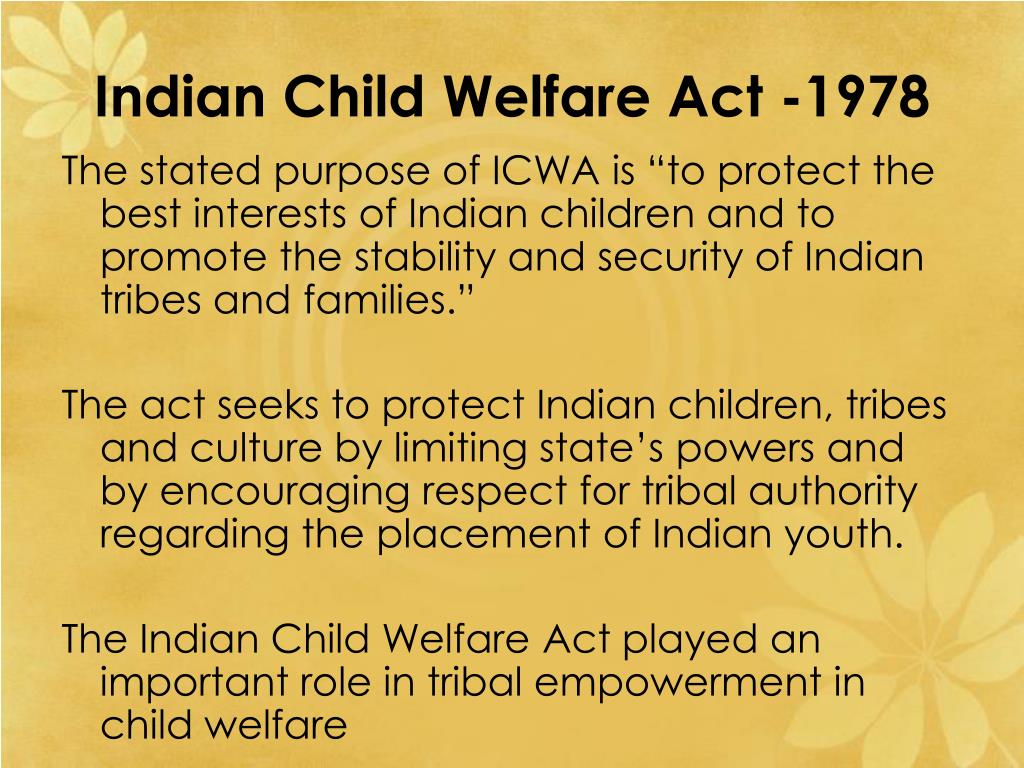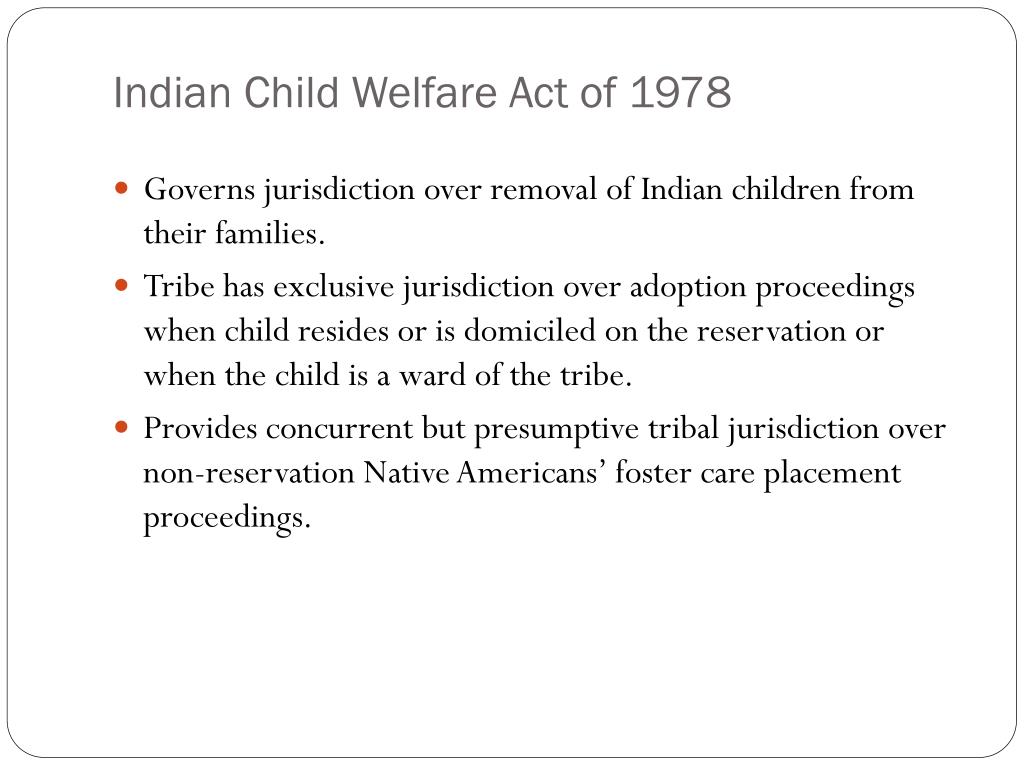
A Shield and a Struggle: The Enduring Impact of the Indian Child Welfare Act
Forty-five years ago, a landmark piece of federal legislation, the Indian Child Welfare Act (ICWA) of 1978, emerged from the shadows of a devastating and often hidden crisis. It was a legislative act born of necessity, a desperate attempt to stem the tide of forced assimilation and cultural destruction that had, for generations, systematically dismantled Native American families and communities. Today, ICWA stands as a cornerstone of tribal sovereignty and a critical protection for Indigenous children, though its journey has been fraught with challenges, culminating in a recent, hard-won affirmation by the highest court in the land.
Before ICWA, the statistics painted a stark and heartbreaking picture. Federal and state child welfare agencies, driven by misguided notions of "saving" Native children or simply by a lack of understanding and cultural competency, routinely removed Indigenous children from their homes, often without cause or due process. Estimates from the 1960s and 70s revealed that between 25% and 35% of all Native American children were separated from their families. Of these, an alarming 85% were placed in non-Native foster or adoptive homes, effectively severing their ties to their cultural heritage, language, and tribal identity.
This wasn’t just a systemic failure; it was the continuation of a colonial legacy that had begun with boarding schools, designed explicitly to "kill the Indian to save the man." The trauma inflicted by these policies was generational, creating deep wounds that continue to affect Native communities today. As tribal leaders testified before Congress, they described a "hemorrhage" of their children, a direct threat to the very survival of their nations. It was this urgent plea that spurred Congress to act, recognizing that the "best interests of the child" for Native children inherently included their connection to their tribe.
The Pillars of Protection: What ICWA Does
Enacted on November 8, 1978, ICWA fundamentally reoriented the legal landscape for Native American children in child welfare proceedings. Its core purpose is "to protect the best interests of Indian children and to promote the stability and security of Indian tribes and families." To achieve this, ICWA established several key provisions:

- Tribal Jurisdiction: It grants tribal courts exclusive jurisdiction over child custody proceedings involving Indian children residing or domiciled within the reservation. For children living off-reservation, it establishes concurrent jurisdiction with state courts but provides for mandatory transfer to tribal court upon petition, unless good cause is shown not to transfer, or the tribe declines.
- Active Efforts: State agencies are required to make "active efforts" to provide remedial services and rehabilitative programs designed to prevent the breakup of the Indian family. This is a higher standard than the "reasonable efforts" typically required for non-Native families, acknowledging the historical context and the need for culturally appropriate interventions.
- Placement Preferences: ICWA establishes a hierarchy of placement preferences for Indian children who must be removed from their homes:
- A member of the child’s extended family.
- A foster home licensed or specified by the child’s tribe.
- An Indian foster home licensed by a non-Indian licensing authority.
- An institution for children approved by an Indian tribe or operated by an Indian organization.

- Higher Evidentiary Standards: To terminate parental rights, ICWA requires evidence beyond a reasonable doubt that the continued custody of the parent or Indian custodian is likely to result in serious emotional or physical damage to the child. This is a higher standard than the "clear and convincing evidence" typically required in state courts.
- Notice Requirements: Tribes must be notified of any state court child custody proceedings involving an Indian child, ensuring their right to intervene and participate.
These provisions were not merely procedural; they were a profound acknowledgment of tribal sovereignty, recognizing tribes as distinct political entities with an inherent right to self-governance and to protect their future generations. "ICWA wasn’t just about kids," explains Sarah Deer, a citizen of the Muscogee (Creek) Nation and a leading scholar on Native American law. "It was about rebuilding nations, ensuring that our children would grow up knowing who they are and where they come from, something generations before them were denied."
A Generation of Change: ICWA’s Positive Impact
Over the past four decades, ICWA has had an undeniable, transformative impact. It has significantly reduced the disproportionate removal of Native children from their homes, though disparities still persist. It has empowered tribal governments to assert their authority in matters concerning their children, fostering the development of tribal child welfare programs and services that are culturally informed and community-led.
For countless Indigenous children, ICWA has meant the difference between a life of cultural disconnection and one rooted in identity and belonging. It has facilitated adoptions by tribal members, ensuring that children maintain connections to their extended families, languages, and traditions. It has also spurred collaboration between state and tribal child welfare agencies, though this relationship remains complex and often strained.
The Act has also been a powerful tool for healing historical trauma. By prioritizing family preservation and culturally appropriate placements, ICWA helps to mend the generational wounds inflicted by past assimilationist policies. It affirms the value of Indigenous cultures and ways of knowing, reinforcing the idea that a child’s best interest is inextricably linked to their cultural context.
A Persistent Battle: Challenges and Controversies
Despite its successes, ICWA has been a constant target of legal and political challenges. Opponents, often adoption agencies, some state officials, and private individuals seeking to adopt Native children, have argued that the law is "race-based," unconstitutional, and does not always serve the "best interests of the child" as they define it.
These challenges frequently centered on constitutional arguments, including claims that ICWA violates the Equal Protection Clause of the Fifth Amendment by treating Indian children differently based on their ancestry, or the Tenth Amendment by commandeering state resources. Critics also argued that ICWA places an undue burden on non-Native foster and adoptive parents and interferes with state sovereignty over child welfare matters.
The most significant and far-reaching challenge came in the form of Haaland v. Brackeen, a complex lawsuit initiated in 2017 by a non-Native couple seeking to adopt an Indian child, along with several states (Texas, Louisiana, and Indiana). The plaintiffs argued that ICWA’s provisions were unconstitutional, essentially seeking to dismantle the law entirely.
The case wound its way through the federal courts, creating immense anxiety and uncertainty within tribal communities. A lower court initially found parts of ICWA unconstitutional, but the Fifth Circuit Court of Appeals, after several hearings, ultimately upheld most of the law. The case then reached the U.S. Supreme Court, which heard arguments in November 2022.
The Brackeen Decision: An Affirmation of Sovereignty
On June 15, 2023, the Supreme Court delivered a resounding victory for tribal sovereignty and the future of Indigenous children. In a 7-2 decision, the Court affirmed the constitutionality of ICWA, largely rejecting the plaintiffs’ claims. Justice Amy Coney Barrett, writing for the majority, emphasized the unique political status of tribal nations, distinguishing between "race" and "political affiliation" in the context of federal Indian law. The Court affirmed that Congress’s power to legislate regarding Indian affairs, derived from the Indian Commerce Clause, allowed it to enact ICWA.
While the ruling was narrow, focusing on the specific constitutional challenges brought by the plaintiffs, its implications were immense. It unequivocally upheld the federal government’s authority to legislate for the benefit of Native American tribes and confirmed that ICWA’s provisions are consistent with the Constitution.
"This decision is a monumental victory for Native children, families, and tribal sovereignty," stated Chuck Hoskin Jr., Principal Chief of the Cherokee Nation, one of the intervening tribes in the case. "It sends a clear message that the U.S. government has a solemn responsibility to protect tribal nations and their citizens, and that our children are not commodities to be stripped of their heritage."
The Road Ahead: Continued Vigilance and Progress
The Brackeen decision, while a cause for celebration, does not mark the end of the struggle for ICWA’s full implementation and protection. Disparities in child removal rates still exist, and some state courts and agencies continue to struggle with compliance or actively resist ICWA’s mandates. Advocates continue to push for better training, increased resources for tribal child welfare programs, and stronger enforcement mechanisms.
ICWA’s impact extends beyond legal victories; it has fostered a deeper understanding of the importance of cultural identity and belonging for all children, not just Native American children. It has highlighted the need for culturally competent child welfare practices and challenged the dominant paradigm of "best interests" to include a child’s heritage as an indispensable component of their well-being.
The Indian Child Welfare Act is more than just a statute; it is a living testament to the resilience of Native American people and their unwavering commitment to protecting their most precious resource – their children. It stands as a powerful shield against the forces of assimilation, ensuring that future generations of Indigenous children will grow up connected to their families, their cultures, and their sovereign nations, ready to carry forward the traditions and wisdom of their ancestors. The fight for its complete and consistent application continues, but its enduring legacy is one of hope, healing, and the unyielding strength of Indigenous identity.

